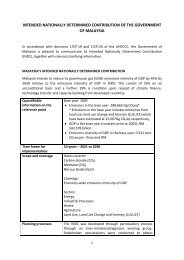RP-01638
RP-01638
RP-01638
You also want an ePaper? Increase the reach of your titles
YUMPU automatically turns print PDFs into web optimized ePapers that Google loves.
cylinder: PVC is one-third the cost of galvanized<br />
pipe. Another reason for the lower<br />
cost was the availability of local contractors<br />
experienced in well drilling and installation of<br />
handpumps. Also, a small motorized rig<br />
costing $4000 was used in well drilling<br />
operations.<br />
Water supply situation<br />
In 1980, only 43% or 21.2 million people out<br />
of a total population of 49.4 million were<br />
served by piped water supplies. Of the rural<br />
population of 34.1 million people, 33%<br />
obtained water from public supply systems,<br />
whereas the rest depended on handpumps,<br />
open wells, rainwater cisterns, and streams.<br />
According to UNICEF statistics, there are<br />
23 572 public artesian wells serving about<br />
4 million people. Only 16 000 of them are<br />
operational and their average drilled depth is<br />
197 feet (60 m) (World Water 1982). The<br />
Philippines has a large reserve of ground<br />
water and a high average annual precipitation,<br />
89 inches (2260 mm).<br />
The use of handpumps has a long history in<br />
the Philippines. In some areas, the majority of<br />
households have installed their own handpumps.<br />
Estimates of the numbers of rural<br />
households of a total of 5.68 million obtaining<br />
water by various means in 1980 are: from<br />
public water supply, 1.87 million; from artesian<br />
wells, 0.39 million; and from privately owned<br />
handpumps, 0.30 million.<br />
These estimates are based on two assumptions:<br />
that an average household includes six<br />
persons; and that there are 30000 privately<br />
owned shallow wells each serving 10 households.<br />
Based on these estimates, over three<br />
million households are still without clean<br />
water for domestic purposes.<br />
To overcome this problem, the Philippines<br />
government has launched a 20-year program<br />
to provide safe and accessible water to all<br />
households. The two main agencies involved<br />
in this rural water supply program are the<br />
Rural Waterworks Development Corporation<br />
(RWDC) and the Ministry of Public Works<br />
(MPW).<br />
Their program is centred on the formation<br />
of beneficiary committees into self-reliant<br />
water-supply associations or cooperatives.<br />
These associations are required to contribute<br />
to the capital cost and undertake the operation<br />
and maintenance of the water-supply system.<br />
The government agencies provide the technical<br />
and institutional assistance as well as<br />
contribute toward the bulk of the cost,<br />
including 10% of the operating and maintenance<br />
expenses.<br />
Three levels of services have been proposed,<br />
depending on the population size of the area,<br />
the source of water supply, the development<br />
cost, and the community's ability to pay. The<br />
government will provide 90% of the capital<br />
cost for Level 1 and loans covering 90% of the<br />
capital cost are available for Levels 2 and 3.<br />
The main emphasis for Level 1 is to develop<br />
point sources such as artesian wells and<br />
protected springs. Each shallow well is<br />
designed to serve a cluster of 15 households,<br />
whereas each deep well will cater to 50 households.<br />
The average installation cost per<br />
household is $12.33 (or $185 per well) for<br />
shallow wells and $98.82 (or $4941 per well)<br />
for deep wells. The annual maintenance cost<br />
is estimated at $0.82 per household.<br />
Level 2 is essentially the same as Level 1<br />
but includes a system of communal faucets.<br />
Its overall design is for a cluster of 100 households,<br />
and the cost per household is $71,<br />
excluding the cost of source development.<br />
Level 3 provides for individual house<br />
connections and the overall design is for<br />
urban households. The capital cost per household<br />
is $247.<br />
The Level 1 program will focus almost<br />
exclusively on the construction and rehabilitation<br />
of shallow and deep wells. The average<br />
depth of shallow wells is 30 feet (9 m), whereas<br />
the deep wells average 200 feet (60 m). By<br />
1990, the RWDC and the MPW plan to install<br />
a total of 169 000 shallow wells and 87 500<br />
deep wells throughout the country. In addition,<br />
a total of 26 000 existing wells will be rehabilitated.<br />
Potential markets<br />
An indication of the potential market for a<br />
low-cost efficient PVC pump can be obtained<br />
by examining the MPW and the RWDC targets<br />
for well construction (Table 2).<br />
The cost of financing the program is<br />
estimated at $368 million. It is expected that<br />
part of this amount will be obtained from loan<br />
or aid programs of various international<br />
agencies. Failure to secure adequate funds<br />
may delay the implementation of this<br />
program.<br />
The rural population in the Philippines is<br />
expected to rise to 43.1 million people or 7.2<br />
million households by 1990. Assuming that<br />
all the proposed pumps are installed by 1990,<br />
61



